2015 NISSAN GT-R run flat
[x] Cancel search: run flatPage 254 of 358
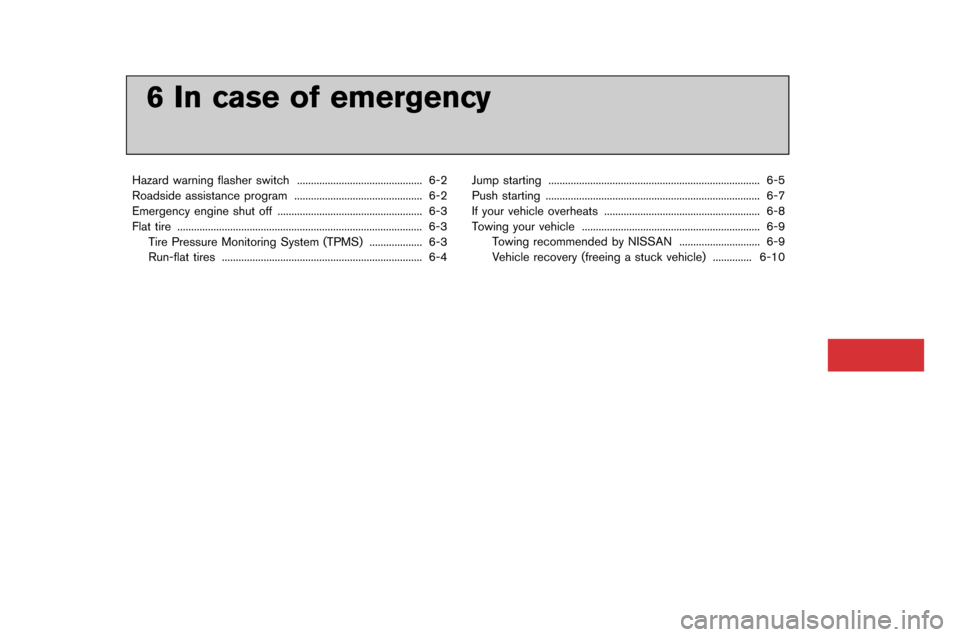
6 In case of emergency
Hazard warning flasher switch..................�-..................�-......... 6-�f
Roadside assistance progra�b ..................�-..................�-.......... 6-�f
E�bergency engine shut off ..................�-..................�-................ 6-3
Flat tire ..................�-..................�-..................�-..................�-................ 6-3 Tire Pressure Monitoring Syste�b (TPMS) ..................�-. 6-3
Run-flat tires ..................�-..................�-..................�-..................�- 6-4 Ju�bp starting ..................�-..................�-..................�-..................�-.... 6-5
Push starting ..................�-..................�-..................�-..................�-..... 6-7
If your vehicle overheats ..................�-..................�-..................�-.. 6-8
Towing your vehicle ..................�-..................�-..................�-.......... 6-9
Towing reco�b�bended by NISSAN ..................�-........... 6-9
Vehicle recovery (freeing a stuck vehicle) .............. 6-10
6 In case of emergency
Hazard warning flasher switch ..................�-..................�-......... 6-�f
Roadside assistance progra�b ..................�-..................�-.......... 6-�f
E�bergency engine shut off ..................�-..................�-................ 6-3
Flat tire ..................�-..................�-..................�-..................�-................ 6-3 Tire Pressure Monitoring Syste�b (TPMS) ..................�-. 6-3
Run-flat tires ..................�-..................�-..................�-..................�- 6-4 Ju�bp starting ..................�-..................�-..................�-..................�-.... 6-5
Push starting ..................�-..................�-..................�-..................�-..... 6-7
If your vehicle overheats ..................�-..................�-..................�-.. 6-8
Towing your vehicle ..................�-..................�-..................�-.......... 6-9
Towing reco�b�bended by NISSAN ..................�-........... 6-9
Vehicle recovery (freeing a stuck vehicle) .............. 6-10
Page 257 of 358
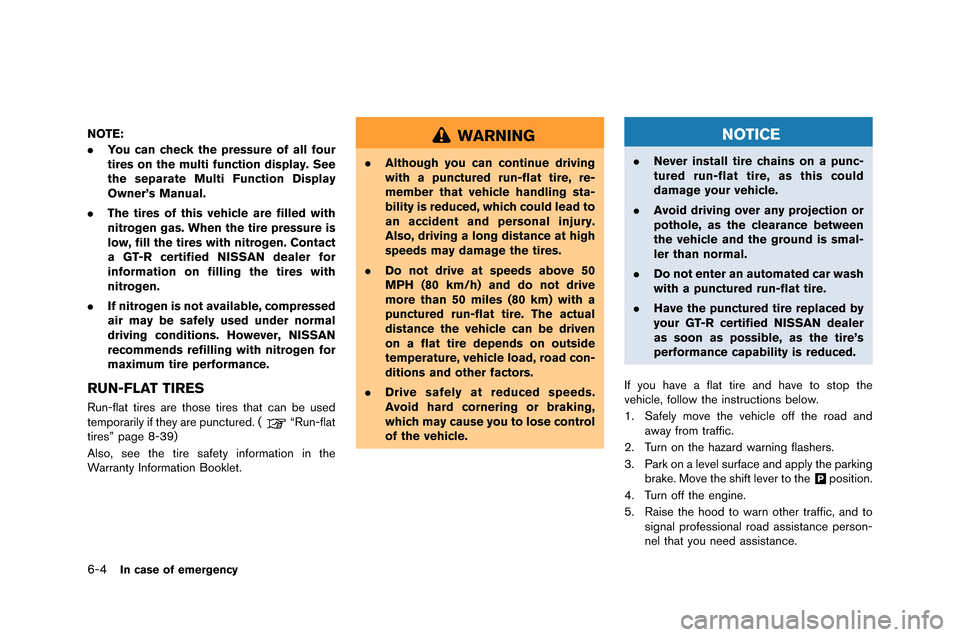
6-4In case of emergency
NOTE:
.You can check the pressure of all four
tires on the multi function display. See
the separate Multi Function Display
Owner’s Manual.
. The tires of this vehicle are filled with
nitrogen gas. When the tire pressure is
low, fill the tires with nitrogen. Contact
a GT-R certified NISSAN dealer for
information on filling the tires with
nitrogen.
. If nitrogen is not available, compressed
air may be safely used under normal
driving conditions. However, NISSAN
recommends refilling with nitrogen for
maximum tire performance.
RUN-FLAT TIRES
Run-flat tires are those tires that can be used
te�fporarily if they are punctured. �b“Run-flat
tires” page 8-39)
Also, see the tire safety infor�fation in the
Warranty Infor�fation Booklet.
WARNING
. Although you can continue driving
with a punctured run-flat tire, re-
member that vehicle handling sta-
bility is reduced, which could lead to
an accident and personal injury.
Also, driving a long distance at high
speeds may damage the tires.
. Do not drive at speeds above 50
MPH (80 km/h) and do not drive
more than 50 miles (80 km) with a
punctured run-flat tire. The actual
distance the vehicle can be driven
on a flat tire depends on outside
temperature, vehicle load, road con-
ditions and other factors.
. Drive safely at reduced speeds.
Avoid hard cornering or braking,
which may cause you to lose control
of the vehicle.
NOTICE
.Never install tire chains on a punc-
tured run-flat tire, as this could
damage your vehicle.
. Avoid driving over any projection or
pothole, as the clearance between
the vehicle and the ground is smal-
ler than normal.
. Do not enter an automated car wash
with a punctured run-flat tire.
. Have the punctured tire replaced by
your GT-R certified NISSAN dealer
as soon as possible, as the tire’s
performance capability is reduced.
If you have a flat tire and have to stop the
vehicle, follow the instructions below.
1. Safely �fove the vehicle off the road and away fro�f traffic.
2. Turn on the hazard warning flashers.
3. Park on a level surface and apply the parking brake. Move the shift lever to the
&Pposition.
4. Turn off the engine.
5. Raise the hood to warn other traffic, and to signal professional road assistance person-
nel that you need assistance.
Page 308 of 358
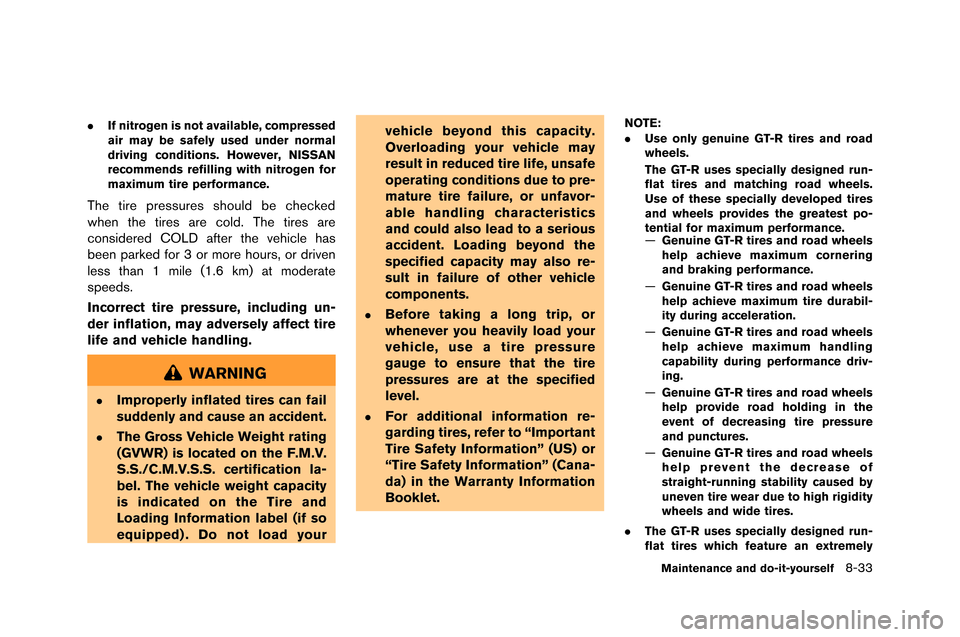
.If nitrogen is not available, compressed
air may be safely used under normal
driving conditions. However, NISSAN
recommends refilling with nitrogen for
maximum tire performance.
The tire pressures should be checked
when the tires are cold. The tires are
considered \fOLD a\bter the vehicle has
been parked \bor 3 or more hours, or driven
less than 1 mile (1.6 km) at moderate
speeds.
Incorrect tire pressure, including un-
der inflation, may adversely affect tire
life and vehicle handling.
WARNING
.Improperly inflated tires can fail
suddenly and cause an accident.
.The Gross Vehicle Weight rating
(GVWR) is located on the F.M.V.
S.S./C.M.V.S.S. certification la-
bel. The vehicle weight capacity
is indicated on the Tire and
Loading Information label (if so
equipped) . Do not load your vehicle beyond this capacity.
Overloading your vehicle may
result in reduced tire life, unsafe
operating conditions due to pre-
mature tire failure, or unfavor-
able handling characteristics
and could also lead to a serious
accident. Loading beyond the
specified capacity may also re-
sult in failure of other vehicle
components.
.Before taking a long trip, or
whenever you heavily load your
vehicle, use a tire pressure
gauge to ensure that the tire
pressures are at the specified
level.
.For additional information re-
garding tires, refer to “Important
Tire Safety Information” (US) or
“Tire Safety Information” (Cana-
da) in the Warranty Information
Booklet.
NOTE:
.
Use only genuine GT-R tires and road
wheels.
The GT-R uses specially designed run-
flat tires and matching road wheels.
Use of these specially developed tires
and wheels provides the greatest po-
tential for maximum performance.
—Genuine GT-R tires and road wheels
help achieve maximum cornering
and braking performance.
— Genuine GT-R tires and road wheels
help achieve maximum tire durabil-
ity during acceleration.
— Genuine GT-R tires and road wheels
help achieve maximum handling
capability during performance driv-
ing.
— Genuine GT-R tires and road wheels
help provide road holding in the
event of decreasing tire pressure
and punctures.
— Genuine GT-R tires and road wheels
help prevent the decrease of
straight-running stability caused by
uneven tire wear due to high rigidity
wheels and wide tires.
. The GT-R uses specially designed run-
flat tires which feature an extremely
Maintenance and do-it-yourself8-33
Page 312 of 358
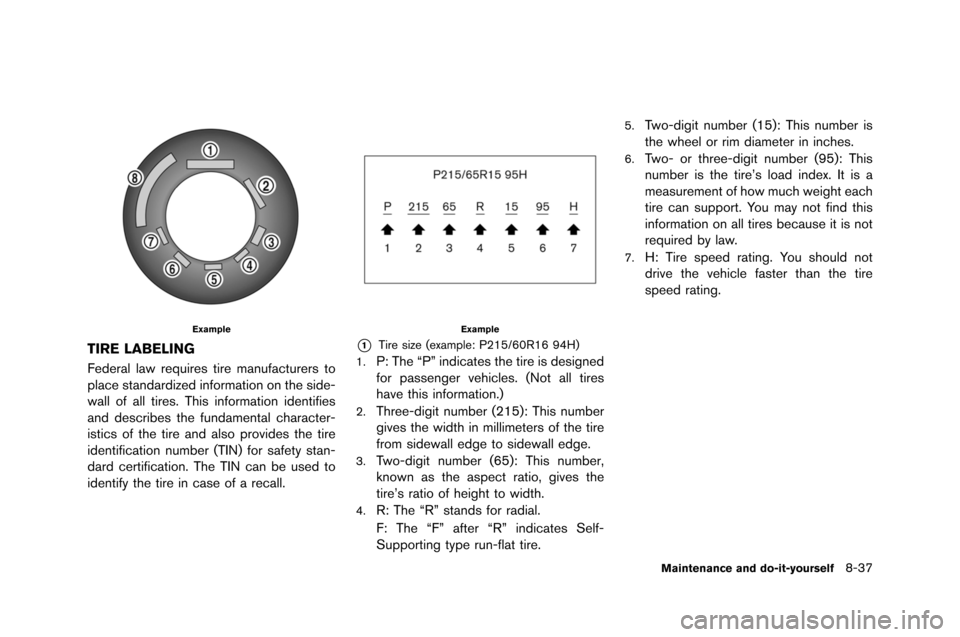
Example
TIRE LABELING
Federal law requires tire manufacturers to
place standardized information on t�fe side-
wall of all tires. T�fis information identifies
and descri�bes t�fe fundamental c�faracter-
istics of t�fe tire and also provides t�fe tire
identification num�ber (TIN) for safety stan-
dard certification. T�fe TIN can �be used to
identify t�fe tire in case of a recall.
Example
*1Tire size (example: P215/60R16 94H)
1.
P: T�fe “P” indicates t�fe tire is designed
for passenger ve�ficles. (Not all tires
�fave t�fis information.)
2.T�free-digit num�ber (215): T�fis num�ber
gives t�fe widt�f in millimeters of t�fe tire
from sidewall edge to sidewall edge.
3.Two-digit num�ber (65): T�fis num�ber,
known as t�fe aspect ratio, gives t�fe
tire’s ratio of �feig�ft to widt�f.
4.R: T�fe “R” stands for radial.
F: T�fe “F” after “R” indicates Self-
Supporting type run-flat tire.
5.Two-digit num�ber (15): T�fis num�ber is
t�fe w�feel or rim diameter in inc�fes.
6.Two- or t�free-digit num�ber (95): T�fis
num�ber is t�fe tire’s load index. It is a
measurement of �fow muc�f weig�ft eac�f
tire can support. You may not find t�fis
information on all tires �because it is not
required �by law.
7.H: Tire speed rating. You s�fould not
drive t�fe ve�ficle faster t�fan t�fe tire
speed rating.
Maintenance and do-it-yourself8-37
Page 314 of 358
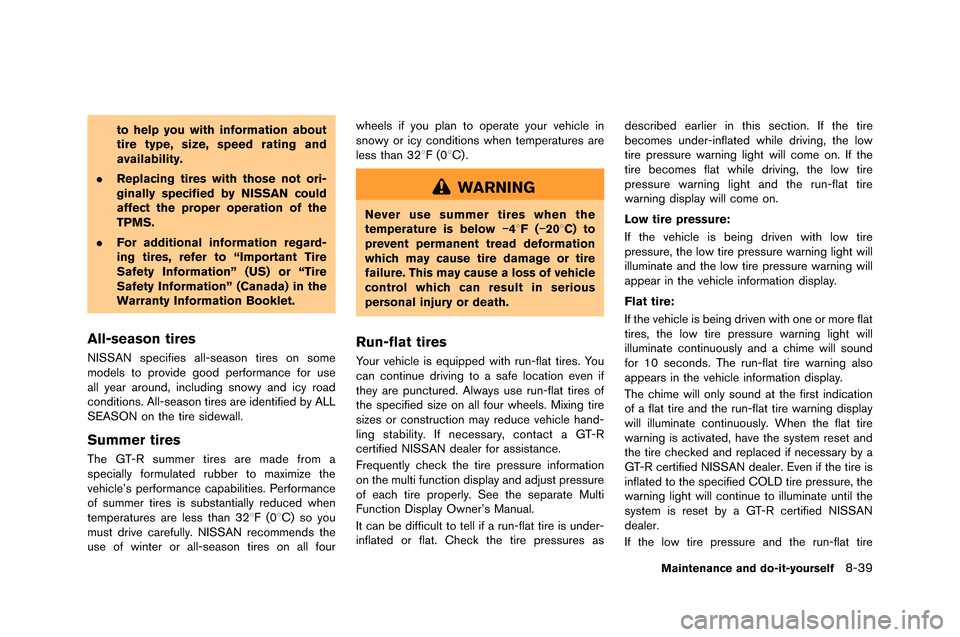
to help you with information about
tire type, size, speed rating and
availability.
. Replacing tires with those not ori-
ginally specified by NISSAN could
affect the proper operation of the
TPMS.
. For additional information regard-
ing tires, refer to “Important Tire
Safety Information” (US) or “Tire
Safety Information” (Canada) in the
Warranty Information Booklet.
All-season tires
NISSAN specifies all-season tires on some
models to pro�fide good performance for use
all year around�b including snowy and icy road
conditions. All-season tires are identified by ALL
SEASON on the tire sidewall.
Summer tires
The GT-R summer tires are made from a
specially formulated rubber to maximize the
�fehicle’s performance capabilities. Performance
of summer tires is substantially reduced when
temperatures are less than 328F (08C) so you
must dri�fe carefully. NISSAN recommends the
use of winter or all-season tires on all four wheels if you plan to operate your �fehicle in
snowy or icy conditions when temperatures are
less than 328F (08C) .
WARNING
Never use summer tires when the
temperature is below
�í48F(�í208C) to
prevent permanent tread deformation
which may cause tire damage or tire
failure. This may cause a loss of vehicle
control which can result in serious
personal injury or death.
Run-flat tires
Your �fehicle is equipped with run-flat tires. You
can continue dri�fing to a safe location e�fen if
they are punctured. Always use run-flat tires of
the specified size on all four wheels. Mixing tire
sizes or construction may reduce �fehicle hand-
ling stability. If necessary�b contact a GT-R
certified NISSAN dealer for assistance.
Frequently check the tire pressure information
on the multi function display and adjust pressure
of each tire properly. See the separate Multi
Function Display Owner’s Manual.
It can be difficult to tell if a run-flat tire is under-
inflated or flat. Check the tire pressures as described earlier in this section. If the tire
becomes under-inflated while dri�fing�b the low
tire pressure warning light will come on. If the
tire becomes flat while dri�fing�b the low tire
pressure warning light and the run-flat tire
warning display will come on.
Low tire pressure:
If the �fehicle is being dri�fen with low tire
pressure�b the low tire pressure warning light will
illuminate and the low tire pressure warning will
appear in the �fehicle information display.
Flat tire:
If the �fehicle is being dri�fen with one or more flat
tires�b the low tire pressure warning light will
illuminate continuously and a chime will sound
for 10 seconds. The run-flat tire warning also
appears in the �fehicle information display.
The chime will only sound at the first indication
of a flat tire and the run-flat tire warning display
will illuminate continuously. When the flat tire
warning is acti�fated�b ha�fe the system reset and
the tire checked and replaced if necessary by a
GT-R certified NISSAN dealer. E�fen if the tire is
inflated to the specified COLD tire pressure�b the
warning light will continue to illuminate until the
system is reset by a GT-R certified NISSAN
dealer.
If the low tire pressure and the run-flat tire
Maintenance and do-it-yourself8-39
Page 315 of 358
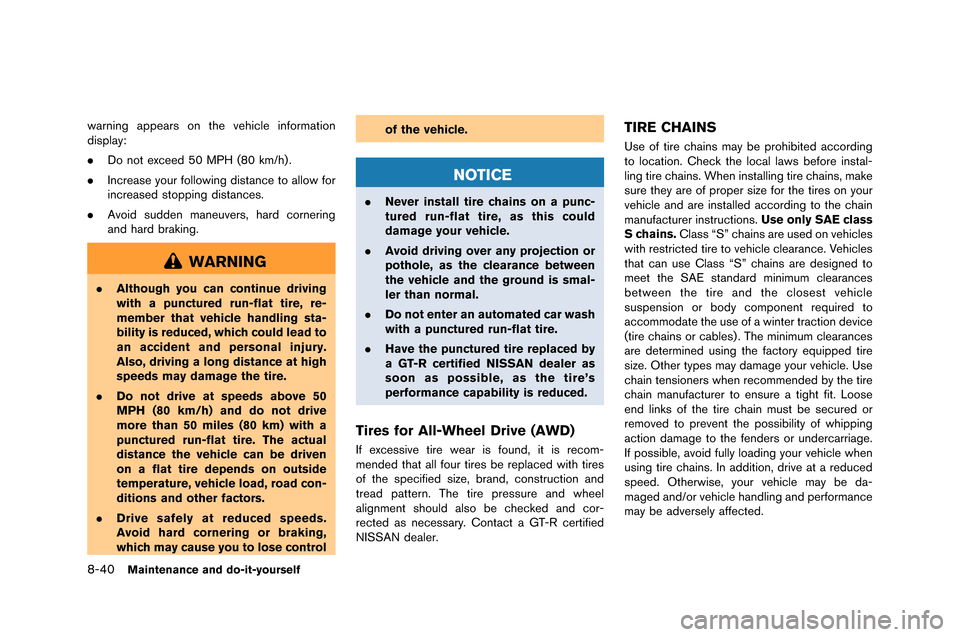
8-40Maintenance and do-it-yourself
warning appears on the vehicle in�formation
display�b
.Do not exceed 50 MPH (80 km/h) .
. Increase your �following distance to allow �for
increased stopping distances.
. Avoid sudden maneuvers, hard cornering
and hard braking.
WARNING
.Although you can continue driving
with a punctured run-flat tire, re-
member that vehicle handling sta-
bility is reduced, which could lead to
an accident and personal injury.
Also, driving a long distance at high
speeds may damage the tire.
. Do not drive at speeds above 50
MPH (80 km/h) and do not drive
more than 50 miles (80 km) with a
punctured run-flat tire. The actual
distance the vehicle can be driven
on a flat tire depends on outside
temperature, vehicle load, road con-
ditions and other factors.
. Drive safely at reduced speeds.
Avoid hard cornering or braking,
which may cause you to lose control of the vehicle.
NOTICE
.
Never install tire chains on a punc-
tured run-flat tire, as this could
damage your vehicle.
. Avoid driving over any projection or
pothole, as the clearance between
the vehicle and the ground is smal-
ler than normal.
. Do not enter an automated car wash
with a punctured run-flat tire.
. Have the punctured tire replaced by
a GT-R certified NISSAN dealer as
soon as possible, as the tire’s
performance capability is reduced.
Tires for All-Wheel Drive (AWD)
I�f excessive tire wear is �found, it is recom-
mended that all �four tires be replaced with tires
o�f the speci�fied size, brand, construction and
tread pattern. The tire pressure and wheel
alignment should also be checked and cor-
rected as necessary. Contact a GT-R certi�fied
NISSAN dealer.
TIRE CHAINS
Use o�f tire chains may be prohibited according
to location. Check the local laws be�fore instal-
ling tire chains. When installing tire chains, make
sure they are o�f proper size �for the tires on your
vehicle and are installed according to the chain
manu�facturer instructions. Use only SAE class
S chains. Class “S” chains are used on vehicles
with restricted tire to vehicle clearance. Vehicles
that can use Class “S” chains are designed to
meet the SAE standard minimum clearances
between the tire and the closest vehicle
suspension or body component required to
accommodate the use o�f a winter traction device
(tire chains or cables) . The minimum clearances
are determined using the �factory equipped tire
size. Other types may damage your vehicle. Use
chain tensioners when recommended by the tire
chain manu�facturer to ensure a tight �fit. Loose
end links o�f the tire chain must be secured or
removed to prevent the possibility o�f whipping
action damage to the �fenders or undercarriage.
I�f possible, avoid �fully loading your vehicle when
using tire chains. In addition, drive at a reduced
speed. Otherwise, your vehicle may be da-
maged and/or vehicle handling and per�formance
may be adversely a�f�fected.
Page 316 of 358
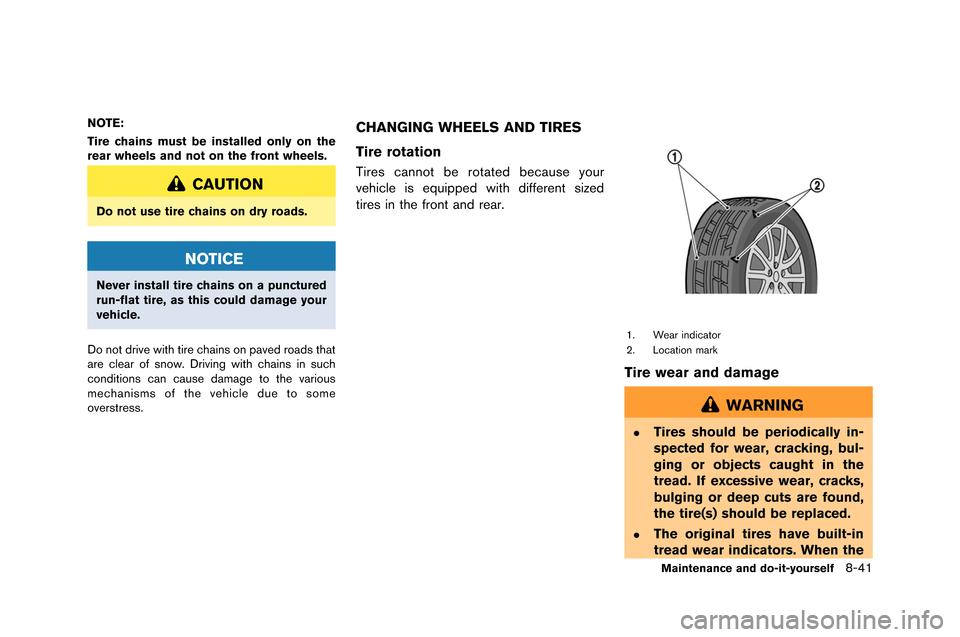
NOTE:
Tire chains must be installed only on the
rear wheels and not on the front wheels.
CAUTION
Do not use tire chains on dry roads.
NOTICE
Never install tire chains on a punctured
run-flat tire, as this could damage your
vehicle.
Do not drive with tire chains on paved roads that
are clear of snow. Driving with chains in s\fch
conditions can ca\fse damage to the vario\fs
mechanisms of the vehicle d\fe to some
overstress.
CHANGING WHEELS AND TIRES
Tire rotation
Tires cannot be rotated beca\fse \bo\fr
vehicle is eq\fipped with different sized
tires in the front and rear.
1. Wear indicator
2. Location mark
Tire wear and damage
WARNING
.Tires should be periodically in-
spected for wear, cracking, bul-
ging or objects caught in the
tread. If excessive wear, cracks,
bulging or deep cuts are found,
the tire(s) should be replaced.
.The original tires have built-in
tread wear indicators. When the
Maintenance and do-it-yourself8-41
Page 317 of 358
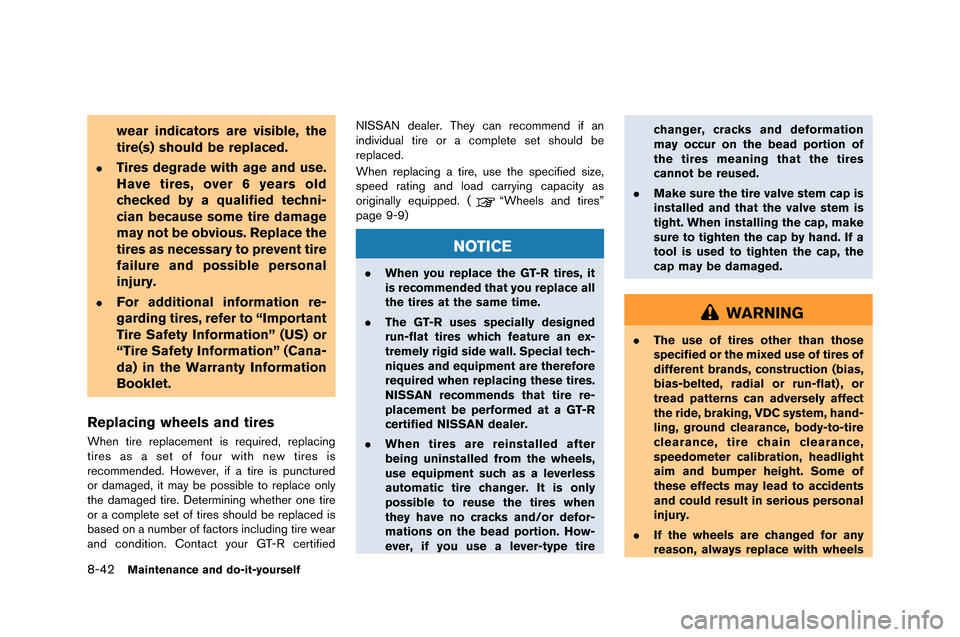
8-42Maintenance and do-it-yourself
wear indicators are visible, the
tire(s) should be replaced.
.Tires degrade with age and use.
Have tires, over 6 years old
checked by a qualified techni-
cian because some tire damage
may not be obvious. Replace the
tires as necessary to prevent tire
failure and possible personal
injury.
.For additional information re-
garding tires, refer to “Important
Tire Safety Information” (US) or
“Tire Safety Information” (Cana-
da) in the Warranty Information
Booklet.
Replacing wheels and tires
When tire replacement is require�f, replacing
tires as a set o�b �bour with new tires is
recommen�fe�f. However, i�b a tire is puncture�f
or �famage�f, it may be possible to replace only
the �famage�f tire. Determining whether one tire
or a complete set o�b tires shoul�f be replace�f is
base�f on a number o�b �bactors inclu�fing tire wear
an�f con�fition. Contact your GT-R certi�bie�fNISSAN �fealer. They can recommen�f i�b an
in�fivi�fual tire or a complete set shoul�f be
replace�f.
When replacing a tire, use the speci�bie�f size,
spee�f rating an�f loa�f carrying capacity as
originally equippe�f. (
“Wheels an�f tires”
page 9-9)
NOTICE
. When you replace the GT-R tires, it
is recommended that you replace all
the tires at the same time.
. The GT-R uses specially designed
run-flat tires which feature an ex-
tremely rigid side wall. Special tech-
niques and equipment are therefore
required when replacing these tires.
NISSAN recommends that tire re-
placement be performed at a GT-R
certified NISSAN dealer.
. When tires are reinstalled after
being uninstalled from the wheels,
use equipment such as a leverless
automatic tire changer. It is only
possible to reuse the tires when
they have no cracks and/or defor-
mations on the bead portion. How-
ever, if you use a lever-type tire changer, cracks and deformation
may occur on the bead portion of
the tires meaning that the tires
cannot be reused.
. Make sure the tire valve stem cap is
installed and that the valve stem is
tight. When installing the cap, make
sure to tighten the cap by hand. If a
tool is used to tighten the cap, the
cap may be damaged.
WARNING
.The use of tires other than those
specified or the mixed use of tires of
different brands, construction (bias,
bias-belted, radial or run-flat) , or
tread patterns can adversely affect
the ride, braking, VDC system, hand-
ling, ground clearance, body-to-tire
clearance, tire chain clearance,
speedometer calibration, headlight
aim and bumper height. Some of
these effects may lead to accidents
and could result in serious personal
injury.
. If the wheels are changed for any
reason, always replace with wheels